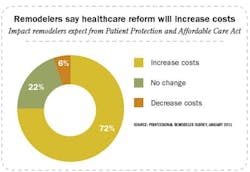Exclusive research: Uncertainty surrounds employee benefits
Most remodelers offer some type of benefits to their employees, but rising costs and new government regulations have them concerned about their ability to so in the future.
That’s according to the latest Professional Remodeler reader study, which found that even in the downturn 84 percent of remodelers offer employee benefits.
Health insurance, time off top list
Not surprisingly, the largest companies were the most likely to have employee benefits. Nearly 90 percent of firms with revenues over $1 million in 2010 did so, compared with 81 percent of firms with less than $1 million in revenue.
Regardless of revenues, the most common benefit remodeling firms have is paid vacation — provided by about half of companies across all revenue levels. That was followed closely by health insurance for employees, offered by 48 percent of all remodeling firms, but 63 percent of firms over $1 million in volume.
Other benefits companies are providing:
• Paid holidays – 46 percent
• Retirement plans/profit sharing – 24 percent
• Paid sick time – 24 percent
• Dependent health insurance – 21 percent
• Employee dental insurance – 17 percent
• Life insurance – 16 percent
• Disability insurance – 14 percent
• Dependent dental insurance – 12 percent
Of those companies that don’t offer employee benefits now, 53 percent had offered them in the past. Forty percent of those firms had offered health insurance, 36 percent had provided paid vacation and 35 percent had given employees paid holidays before eliminating them.
In fact, almost half of all remodeling firms have eliminated some employee benefits over the last two years. The most common were health insurance, retirement plan/profit sharing and paid vacation, all cut by about 10 percent of companies. Company owners cited several reasons why they had cut benefits:
• “Company downsized due to recession and cost of providing insurance increased so much we just could not afford to provide it.”
• “Costs outweighed volume of business.”
• “Employees chose not to have me take care of that for them.”
• “Quit offering them to new hires and paid them a little more.”
At the same time, 11 percent of firms have added benefits in the last two years, most commonly profit sharing and health insurance.
Rising costs
Most remodeling firms that offer benefits spend somewhere between $1,000 and $10,000 per employee on those benefits – 36 percent spend $1,000 to $5,000 and 32 percent between $5,000 and $10,000. Seventeen percent spend $10,000 to $20,000, while 10 percent spend less than $1,000 and 5 percent spend more than $20,000 per employee.
The vast majority of companies have experienced an increase in costs over the last two years, with 64 percent reporting an increase; 21 percent have seen increases of more than 25 percent in what they pay for benefits.
There were several reasons behind the increase, respondents said, with most having to do with the increased cost of healthcare:
• “Government over-regulation of small business.”
• “Rising healthcare insurance rates.”
• “Employees are in their 60s and costs are high even with a high deductible.”
• “Workman’s comp has increased.”
• “Pay increases, therefore higher costs for vacations and holidays.”
• “Obama Care – our company will be forced to make significant reductions in the type of coverage we can afford to offer.”
• “Our desire to offer a competitive package that allows us to hire the best people.”
While 14 percent of companies are paying less for benefits than they were two years ago, most of that was because of a cut in benefits or a higher percentage of the cost being passed on to the employees. Some remodelers also reported achieving cost savings by implementing new plans, such as Healthcare Savings Accounts.
“It’s a necessity to meet the demands of lower income in the down economy, not because I wanted to,” said one remodeler.
“The economy forced us to cut benefits or let more employees go,” said another.
Remodelers are not optimistic that government healthcare reform will improve the situation. Seventy-two percent of remodelers expect it to increase their costs of doing business and only 6 percent expect it to lower their costs. About 22 percent expect no change.
Finally, despite offering benefits, most remodeling company owners do not get their personal health insurance from their own company. About 38 percent have insurance through their own firm, and another 32 percent buy directly from an insurer.
Fourteen percent of remodelers get insurance from their spouse or partner’s employer and 7 percent have insurance from another source such as Medicare or retired military benefits. Almost 10 percent of remodelers don’t have insurance.
